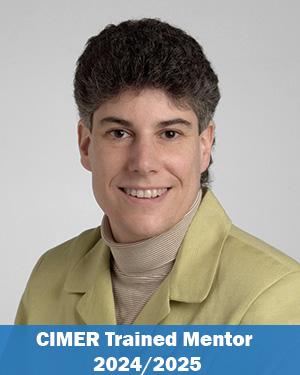Research News
05/09/2019
The Potential Regenerative Power of Mesenchymal Stem Cells for Ischemic Kidney Injury
Mesenchymal stem cell (MSC) secretion have anti-inflammatory, anti-fibrotic, pro-angiogenic and anti-apoptotic properties that support regeneration.

Prolonged interruption of renal blood supply from renal artery clamping during partial nephrectomy, followed by reperfusion, can cause tissue injury and necrosis, resulting in organ dysfunction and chronic kidney disease. Effective therapies for renal ischemia-reperfusion injury (IRI) are lacking and urgently needed.
New preclinical research, led by Margot Damaser, PhD, Department of Biomedical Engineering, shows that mesenchymal stem cell (MSC) secretions improve recovery of renal function, and reveals some facets of how the secretions produce that beneficial effect. Dr. Damaser presented the findings at the 2019 annual meeting of the American Urological Association (AUA).
MSCs are a type of mature stem cell found in bone marrow and almost all well-vascularized tissue. Their capacity for proliferation and differentiation into multiple terminal cell types, as well as the therapeutic potential of the bioactive molecules they secrete, make MSCs a target of great interest in regenerative medicine, particularly in urologic applications.
MSCs’ secreted molecules, including growth factors, cytokines and hormones—collectively known as the secretome—have anti-inflammatory, anti-fibrotic, pro-angiogenic and anti-apoptotic properties that support regeneration, but without risk of oncogenic transformation and immunoreactivity, as is associated with traditional stem cell therapy. As such, modification and therapeutic application of MSC secretome components could, in theory, serve as a customized regenerative drug delivery system to improve outcomes in various conditions.
Testing regenerative potential
The two studies Dr. Damaser and colleagues presented at the AUA meeting described their efforts to further characterize the MSC secretome and use it to mitigate loss of kidney function following IRI.
To investigate MSC secretions’ regenerative potential, the researchers harvested bone marrow from a preclinical model to obtain and grow MSCs in culture. When concentrated, the solution is called MSC-conditioned culture media (CCM).
In the initial study, the researchers simulated IRI in a preclinical model by clamping the left renal hilum following right nephrectomy. They observed the effects of administering CCM just before clamping on serum creatinine (SCr) levels, whose level over baseline is a marker for acute kidney injury. By day 7 post-IRI, CCM administration resulted in significantly lower SCr levels relative to baseline than normal saline or plain media administration, suggesting that MSC secretions are protective and improve renal function following IRI.
In a second arm of the initial study, the researchers examined how varied CCM delivery methods affect the strength of the observed therapeutic benefit. By day 14 post-IRI, intra-arterial and subcutaneous CCM delivery resulted in significantly lower SCr levels than those untreated. Additionally, CCM treatment led to less renal tubular dilation and less loss of cellular structure. Since the improvement occurred regardless of CCM delivery route and both of the best performing routes are systemic rather than local, these findings suggest that the beneficial effects of the MSC secretome are delivered via a systemic mechanism of action.
In the follow-up study, Dr. Damaser and her colleagues sought to learn more about the mechanisms of secretome-mediated renal IRI recovery. They focused on MSC-derived extracellular vesicles called exosomes, which are thought to contain some of the bioactive cytokines secreted by MSCs.
As before, the researchers used MSC cultures derived from a preclinical model to produce CCM. They isolated exosomes from the CCM, and preserved the exosome-depleted CCM. The team followed the same procedures as in the first study to simulate IRI in a preclinical model. Just before clamping, the researchers administered either intravenous CCM, non-conditioned plain media, MSC-derived exosomes or exosome-depleted CCM and measured SCr levels on multiple days post-IRI.
By day 14, those treated with MSC-derived exosomes had significantly lower SCr levels relative to baseline than those that received plain media, and those treated with exosome-depleted CCM or plain media had significantly higher SCr levels relative to baseline than those that received CCM, suggesting that exosomes are at least partially responsible for mediating the therapeutic benefit.
“Both findings are noteworthy and build on each other,” Dr. Damaser says. “One demonstrates that we can provide treatment with the secretions of MSCs instead of the cells themselves, and we don’t have to administer treatment locally. Secretome-based therapy may have cost benefits compared to traditional stem cell therapy, particularly since an off-the-shelf formulation may be given. Our other result begins to home in on the mechanism by which these secretions work, or at least what components are producing the therapeutic effect.”
Currently, Dr. Damaser is working on tracking where the exosomes home or travel to, which would suggest how and where they are working to have their regenerative and reparative effects.
This story was adapted from Consult QD.
Image: Mesenchymal stem cells
Featured Experts
News Category
Related News
Research areas
Want To Support Ground-Breaking Research at Cleveland Clinic?
Discover how you can help Cleveland Clinic save lives and continue to lead the transformation of healthcare.
Give to Cleveland Clinic